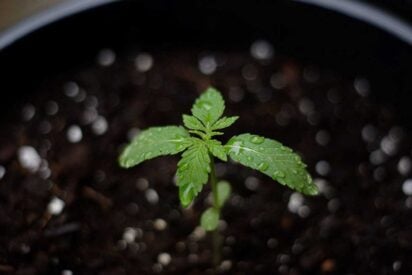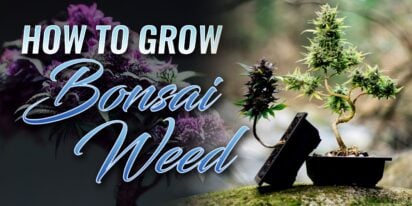
Are You 18 Or Over?
YesOr
No By clicking yes, you certify that you are over 18. By using this website, you agree to our legal disclaimer.605+ Cannabis Strains over 20 Breeders worldwide.
Table of Contents

Cannabis horticulture is a great endeavor to pursue, especially nowadays, with improved technologies and techniques. Horticulturists have discovered the perfect strategies to maximize the yield that you can get from these plants. For beginners, it is important to make an effort to master the basic processes and be educated about the autoflower grow cycle.
Just like cultivating any type of plant, growing cannabis plants is both an art and science. There is a distinct system that you should follow in order to properly go through the process of cannabis growth. It can also be seen as an art because growers express their creativity, resourcefulness, and patience in order to complete a life cycle.
Beginners might encounter challenges and trials in this type of adventure – but, giving up after one mistake will lead them to miss the beautiful opportunity of harvesting the fruits of their labors. Similar to other endeavors that people pursue in life, it takes practice, correction, and repetition until you can manage to perfect the harvest of potent and dank buds that will reward all of your hardwork.
The life cycle of an autoflowering plant begins once you germinate its seeds. You can start by getting your hands on the seeds of your preferred autoflowering cannabis strain. There are different ways that you can try germinating the seeds. You can check them all out and decide to go for the one that works best for you.
Most cannabis growing experts recommend soaking the seeds in a glass of water within a minimum of 24 hours. Then, you should place the autoflower seeds into a damp paper towel and store them into a ziplock plastic bag. Others place the wet seeds in a plate over a damp paper towel and cover it with another plate. With these methods, you will be able to notice the seed-producing roots, signaling that the seedlings can be transferred to their permanent growing medium.
On the other hand, some growers just prepare the seeds and stick them inside the soil and just wait for them to grow. This can be done as well, and it adds excitement to the growing process.
Once the seeds are successfully transferred into their growing medium, usually soil, they will start their upward and downward development. Eventually, after about one day or two, the seed that you planted will emerge upwards. While waiting, make sure that you will be patient, and you will not bother the plant that you have planted. Being tempted to try assisting the seedling will just hinder and halt its growth much further.
This point of the plant’s growth can be considered the most important – because this will tell you if the seed will develop successfully or not. If you injure the plant or hurt it at this point, there is a great chance that the plant will be unable to recover. During this time, if you are growing indoors, make sure that the plant receives enough light. It would be best to place the plant about 17 to 20 inches above the growing seedling.
This stage occurs once your autoflowering seed begins developing its first two ‘real’ leaves. In the very first week, your plant will not ask for too much, just watering daily. If you want to sustain them through the use of nutrients, you should not go further than 1/8 of the mature plant recommended value.
It is also important to note that though the plant thrives in being watered, going overboard can drown your plant and kill them. Again, it is important to be patient and stick with the recommendations for watering your plant. Watering should not leave the plant too dry or dripping wet. The preferred situation is just enough to keep the soil moist.
Eventually, you will notice new sets of leaves appearing and the plant starting to develop a stronger stance. This is the point when you can start providing the recommended nutrients – just stick with mild ones so that the plant will not be overwhelmed.
By the third week of the autoflower grow cycle, your plant will also show their sex. If you are planting regular autos, you must distinguish the females from the males. The female plants have pistils, and the males will have sacs containing pollen. If you have a mix of males and females and you only plan to produce buds and not seeds, separate the males from the females so that pollination will not occur. On the other hand, if you are planting feminized seeds, you will not encounter any problem with this.
At this point, your plant will continue to grow until it reaches its matured size. To control too much height, you can apply different plant training techniques like pruning and FIMing. Make sure that at this stage, the plant receives all the levels of nutrients that it needs. Also, it would do you good to regulate the pH levels, and you can do so by using the proper nutrient mixes.
By the fifth or sixth week of growth, you will start seeing your plant developing beautiful flowers. This would be the perfect time to provide blooming nutrient mixes.
By using blooming nutrients, growers will notice the plant developing strong aromas and expressing its beautiful colors. Maintain providing them with these until about the 9th week of growth. Then, you should stop feeding them and start flushing.
Flushing is a process that makes use of water to remove extra nutrients and avoid the unnecessary buildup of chemicals. This will improve the taste and effects of your weed – losing the chemical taste of your buds.
At this point, you are free to begin harvesting your beautiful buds. Remember to use gloves and sterilized scissors to avoid contaminating your precious flowers.
The autoflower grow cycle might seem intimidating on the first encounter, but mastering this will be worth it once you have your harvest in your hands. Just remember to dry and cure them properly so you can store them for a long time and make the most of their potency and quality.

In recent years, the discourse surrounding secondhand marijuana smoke has gained significant attention, paralleling the legalization and increas

In the realm of cannabis culture, the practice of "wake and bake" holds a significant place, accompanied by both supporters and skeptics. As exp

Introducing the robust indica strain known as Critical Mass weed, a harmonious fusion of Afghani and Skunk #1 genetics. Delve into its essence,

Fusarium wilt cannabis represents a significant threat to cannabis cultivation, necessitating a comprehensive understanding of its intricacies.

1980s were a time of profound cultural transformation, marked by iconic fashion, music, and movies. Alongside these trends, a unique facet of '8

[ez-toc] In the deep history of cannabis cultivation, there exists a captivating and creative practice that combines the art of cultivation wit

For growers looking to get better yields and healthier cannabis plants, it's important to understand and control the cannabis soil pH levels. pH

[ez-toc] In indoor gardening, maintaining an optimal temperature within your grow tent is crucial for the health and productivity of your plant

[ez-toc] Welcome to the delightful world of cannafudge crafting, where sweetness meets sophistication, and cannabis infusion adds a unique twis

[ez-toc] You’ve finished trimming your weed, but what about those leftover stems? Don’t throw them away! These seemingly useless bits can a

Are You 18 Or Over?
YesOr
No By clicking yes, you certify that you are over 18. By using this website, you agree to our legal disclaimer.